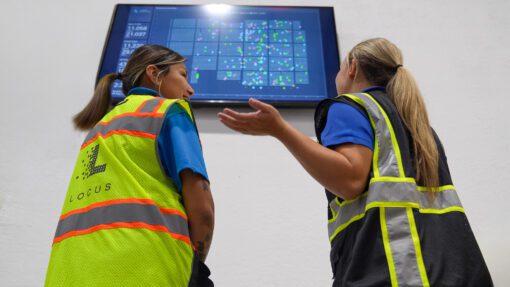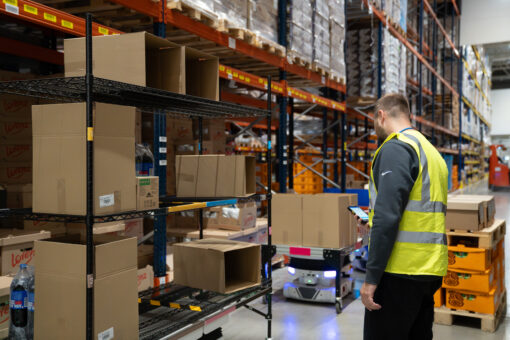WP: How to achieve 400 UPH with Locus Fast Pick
WP: How to achieve 400 UPH with Locus Fast Pick Download Now!
Starting Your Warehouse Automation Journey: Top Industry Insights
Mary Hart, Sr. Content Marketing Manager

As technology continues to evolve, more businesses are looking toward warehouse automation as a means to stay competitive and efficient. But where should a company begin on this journey? In a recent episode of Warehouse Automation Matters, I sat down with Andy Johnston, the Senior Director of Innovation at GEODIS, to discuss the crucial first steps for warehouses that are considering automation. Our conversation covered everything from identifying the right problems to solve, to assessing readiness, and finding the right partners.
Identify the Problem Before the Solution
One of the main points Johnston emphasized is the importance of starting with a clear understanding of the problem you’re trying to solve. With the abundance of automation technologies available today, it’s easy to get distracted by shiny new tools. But as Johnston wisely pointed out, “Without coming into that focused on what you want to solve, you’re going to be distracted with everything that’s there.”
So, where should you start when you’re thinking about automating your warehouse?Johnston recommends beginning by looking at your existing workflows:
- Where are the bottlenecks?
- What processes are consuming the most time and resources?
Once you’ve pinpointed these areas, you can begin to explore automation solutions that are tailored to those specific challenges. As Johnston explained, the key is to reduce unnecessary travel within the warehouse, streamline the movement of inventory, and ultimately, make the daily work lives of your associates easier.
Assess Readiness: Is Your Warehouse Automation-Ready?
Another critical consideration Johnston discussed was assessing whether your warehouse is even ready for automation. This isn’t just about the technology itself but about the physical attributes and layout of your facility. For example, things like aisle width, floor quality, and even facility cleanliness can significantly impact the effectiveness of automation technologies like autonomous mobile robots (AMRs).
Johnston mentioned that while it’s easier to incorporate automation into a greenfield site — a new or recently constructed facility — there are still many options for retrofitting existing facilities. However, it’s essential to understand the limitations and requirements of the technology you plan to implement. For instance, some automation solutions may struggle with navigating uneven surfaces or passing through narrow aisles, so these factors need to be taken into account early in the planning process.
Find the Right Partner for Your Automation Journey
Once you’ve identified the problem and assessed your warehouse’s readiness, the next step is finding the right partner to help you implement the solution. Johnston highlighted the importance of working with vendors who are not just experts in their technology, but who also understand the unique challenges of warehouse operations. “There are a lot of very intelligent roboticists out there, but understanding the ins and outs of a warehouse can prove to be extremely important,” he said.
Johnston also underscored the value of establishing a partnership rather than a purely transactional relationship. A good partner will not only provide the hardware and software but will also collaborate with you to ensure the solution is integrated smoothly into your operations. This collaboration is crucial, as it allows for continuous improvement, optimization, and adaptation as your business needs evolve.
Avoid Common Pitfalls
With so many automation technologies available, it’s easy to make mistakes when selecting the right one for your business. Johnston warned against the allure of the “shiny object” — technologies that look impressive but don’t necessarily fit your business needs. He advised that companies should have in-depth conversations with potential partners, asking about user interfaces, the company’s experience in warehouse operations, and real-world examples of their technology in action.
A critical piece of advice from Johnston was to ensure that any technology you implement provides the necessary visibility into your operations. “You don’t want a solution that can move from point A to point B, but once I hand it over to the system, I have no idea where that inventory is. I don’t know if it’s done, I don’t know if it’s in progress. That visibility is crucial,” he stressed.
Overcome Hesitations
For companies that might be hesitant to take the plunge into warehouse automation, Johnston’s advice was clear: the demand for faster, more efficient operations is only going to increase. Failing to adopt new technologies could place your business at a competitive disadvantage. However, he also cautioned that it’s crucial to prioritize the right technology — automation for the sake of automation isn’t the answer.
Johnston acknowledged that while there are challenges in implementing new technologies, the benefits — such as increased throughput and improved associate retention — make it a worthwhile endeavor. He encouraged companies to reach out to others who have gone through the process to learn from their experiences.
Looking to the Future: The Role of Innovation
As we wrapped up our discussion, Johnston shared his thoughts on the future of warehouse automation. He believes that we’re still in the early stages of what’s possible, with much more innovation to come. The future, as he sees it, involves more collaboration between humans and robots, with technology becoming faster, smarter, and more capable of handling complex tasks. This shift will also create new, more specialized roles within the industry, offering associates the opportunity to develop new skills and advance their careers.
Key Takeaways
If you’re considering warehouse automation, start by clearly identifying the problem you want to solve. Assess whether your facility is ready for automation, and find a partner who understands both the technology and the intricacies of warehouse operations. Avoid common pitfalls by focusing on the right solution for your business, not just the most impressive-looking technology. And finally, don’t be afraid to take the plunge — while the road to automation can be challenging, the benefits far outweigh the risks.
If you want to dive deeper into this topic, I highly recommend listening to the full episode of Warehouse Automation Matters where Andy Johnston and I explore these insights in even greater detail. You can catch the episode here.




